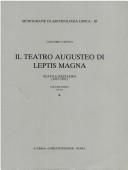| Listing 1 - 5 of 5 |
Sort by
|
Book
Year: 1952 Publisher: Paris : Arts et métiers graphiques,
Abstract | Keywords | Export | Availability | Bookmark
 Loading...
Loading...Choose an application
- Reference Manager
- EndNote
- RefWorks (Direct export to RefWorks)
Inscriptions, Punic --- Inscriptions puniques --- Constantine, Algeria (City) --- Antiquities
Book
Year: 1965 Volume: 88.Bd., 2.Abh. Publisher: Wien : H.Böhlaus Nachf., Kommissionsverlag der österreichischen Akademie der Wissenschaften,
Abstract | Keywords | Export | Availability | Bookmark
 Loading...
Loading...Choose an application
- Reference Manager
- EndNote
- RefWorks (Direct export to RefWorks)
Inscriptions, Etruscan --- Inscriptions, Punic --- Inscriptions étrusques --- Inscriptions puniques --- Ishtar (Divinité assyro-babylonienne) --- Ishtar --- Pyrgi (Extinct city) --- Pyrgi (Ville ancienne)
Book
ISBN: 9782877543293 2877543293 Year: 2015 Volume: 51 3 Publisher: Paris: Académie des inscriptions et belles-lettres,
Abstract | Keywords | Export | Availability | Bookmark
 Loading...
Loading...Choose an application
- Reference Manager
- EndNote
- RefWorks (Direct export to RefWorks)
Stele (Archaeology) --- Inscriptions, Punic --- Stèles (Archéologie) --- Inscriptions puniques --- Maktar (Tunisia) --- Tunisia --- Maktar (Tunisie) --- Tunisie --- Antiquities --- Antiquities. --- Antiquités --- Antiquités préhistoriques --- Maktar (Tunisie ; région) --- Stèles (Archéologie) --- Antiquités
Book
ISSN: 0777978X ISBN: 9789042931619 9042931612 Year: 2015 Volume: 237 21 Publisher: Leuven: Peeters,
Abstract | Keywords | Export | Availability | Bookmark
 Loading...
Loading...Choose an application
- Reference Manager
- EndNote
- RefWorks (Direct export to RefWorks)
The volume contains studies dealing with Mediterranean history in the first millennium B.C., based mainly on epigraphic data. Chapter I concerns the Philistines and the kingdom of "terra firma", established by "Sea Peoples" on the Lower and Middle Orontes and in the Aleppo area, showing their Mycenaean background. Their obvious relations with the Phoenicians lead to the presentation of the newly identified material referring to the goddess Tanit, best known from Carthage, but coming from the Levant. Information provided by classical sources is then discussed in two chapters dealing with Herodotus and with later sources giving some information on Phoenician and Punic law and jurisprudence. The second part of the book consists in an analysis of Phoenician, Punic, and Neo-Punic inscriptions which so far have not been fully deciphered or interpreted. Most of them come from North Africa, but inscriptions from Ibiza and Sardinia are examined as well. Some of them offer the possibility of better understanding the molk-sacrifice and its human implications, especially in the second and first centuries B.C. Attention is paid also to the meaning and the implications of some personal names appearing in those inscriptions.
Phoenician antiquities --- Punic antiquities --- Sea Peoples --- Ethnology --- Academic collection --- Phoenician antiquities. --- Punic antiquities. --- Sea Peoples. --- Peuples de la Mer --- Inscriptions phéniciennes --- Inscriptions puniques --- Méditerranée (région) --- Histoire --- Mediterranean region --- Inscriptions [Phoenician ] --- Inscriptions [Punic ] --- History --- Antiquities [Phoenician ] --- Histoire. --- Ethnology - Mediterranean region

ISBN: 8870626121 9788870626124 Year: 1987 Volume: 3 Publisher: Roma: L'Erma di Bretschneider,
Abstract | Keywords | Export | Availability | Bookmark
 Loading...
Loading...Choose an application
- Reference Manager
- EndNote
- RefWorks (Direct export to RefWorks)
Inscriptions, Punic --- Inscriptions puniques --- Tripolitania --- Tripolitaine --- Antiquities --- Antiquités --- Architecture, Roman --- Theaters --- Architecture romaine --- Théâtres --- Leptis Magna (Tripoli) --- Libya --- Libye --- Antiquities, Roman --- Antiquités romaines --- -Antiquities --- -Inscriptions, Phoenician --- 725.827093974 --- 930.1028 --- Arts Architecture Public structures buildings for outdoor performances and for athletic and outdoor sports and games North Africa Tripolis --- History Archaeology Techniques, procedures, apparatus, equipment, materials --- -725.827093974 --- -Architecture, Roman --- Théâtres --- Antiquités romaines --- Antiquités --- -Tripoli (Regency) --- Ṭarābulus --- Ṭripoliṭanyah --- Tripolitania (Territory under British occupation, 1942-1951) --- Ṭarābulus (Libya : Province) --- Inscriptions puniques. Tripolitaine. --- Inschriften (Punische). Tripolitanië. --- Leptis Magna. Théâtre. Fouilles. 1937-1951. --- Leptis Magna. Schouwburg. Opgravingen. 1937-1951. --- Antiquities. --- -Tripolitania (Territory under British occupation, 1942-1951) --- Tripoli (Regency) --- Tripolitania - - Antiquities --- -Tripolitania --- -Inscriptions, Punic --- -Inscriptions puniques. Tripolitaine. --- -Tripolitania -
| Listing 1 - 5 of 5 |
Sort by
|

 Search
Search Feedback
Feedback About UniCat
About UniCat  Help
Help News
News